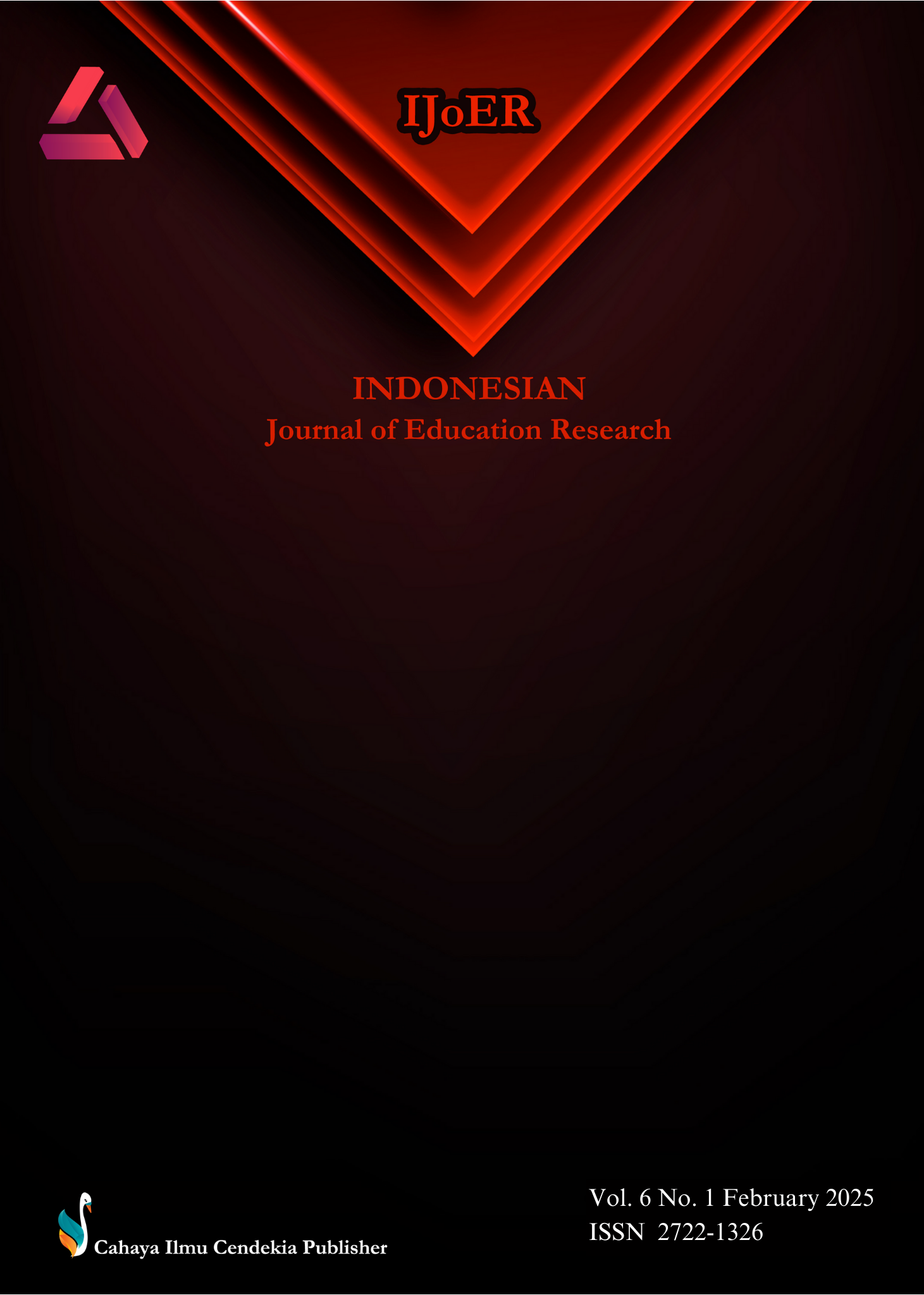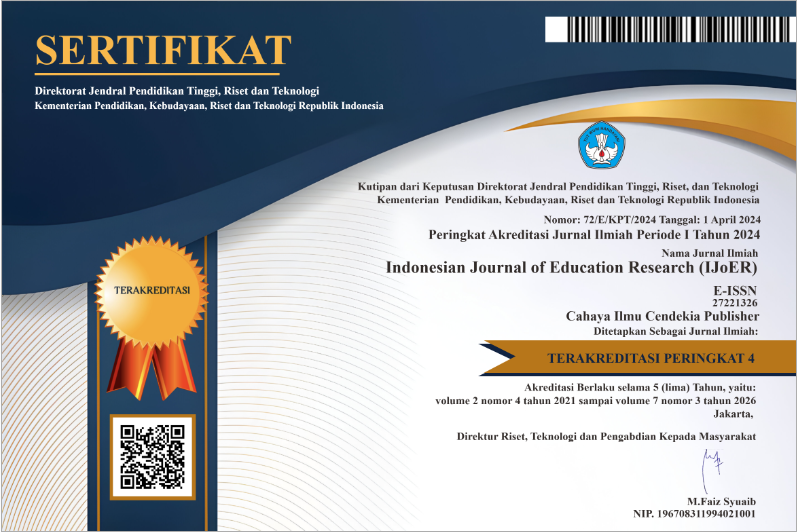The Feasibility of a Mini Dictionary of Literary Text Terms as a Learning Medium for Class XI Students at Al-Washliyah 1 Senior High School Medan
Abstract
Purpose of the study: This study aimed to develop a Mini Dictionary of Literary Text Terms as a learning medium for Class XI students at Al-Washliyah 1 Senior High School Medan to improve their understanding of literary concepts and terminology.
Methodology: This study employed the Research and Development (R&D) method, following the Borg and Gall development model. Data collection involved observation and questionnaires. The study included 62 students from Class XI Science and Social Science streams, with a sample of 31 students from Class XI Science. Expert validation assessments were conducted by two material experts, two design experts, and a teacher.
Main Findings: Validation results from Material Expert I (92%) and Material Expert II (77%) classified the dictionary as "Decent." Design Expert I (84%) rated it as "Decent," while Design Expert II (90%) categorized it as "Very Decent." The teacher’s evaluation resulted in a "Very Decent" (87%) rating. These findings indicate that the Mini Dictionary of Literary Text Terms is valid and suitable as a learning medium for Class XI students.
Novelty/Originality of this study: This study introduces a specialized Mini Dictionary tailored for Class XI students, enhancing literary text learning through a structured and validated resource. The findings contribute to literacy development in Indonesian high schools by offering a pedagogically sound and validated learning tool that improves students' comprehension of literary terminology.
References
Undang Undang No 20 Tahun 2003 tentang System Pendidikan Nasional, 2003
P. Kahrel, “Databases, Core: Linguistics, Online Grammars, and Dictionaries,” in International Encyclopedia of the Social & Behavioral Sciences, Elsevier, 2001, pp. 3248–3251. doi: 10.1016/B0-08-043076-7/00033-4.
L. E. Hidayat, Y. Basthomi, and R. Afrilyasanti, “Exploring Secondary School Teachers’ Creativity in Differentiated Instruction (DI) Practices Across Indonesian EFL Alassrooms,” Think Skills Creat, vol. 53, p. 101620, Sep. 2024, doi: 10.1016/j.tsc.2024.101620.
S. Setiawati, “Penggunaan Kamus Besar Bahasa Indonesia (KBBI) dalam Pembelajaran Kosakata Baku dan Tidak Baku pada Siswa Kelas IV SD,” Jurnal Gramatika: Jurnal Penelitian Pendidikan Bahasa dan Sastra Indonesia, vol. 2, no. 1, pp. 44–51, 2016.
V. Erisa, “Pengembangan Kamus Mini Kumpulan Rumus Bangun Ruang untuk Siswa Tingkat SMP/MTs,” IAIN Palopo, Palopo, 2020.
A. Wicaksono, Menulis Kreatif Sastra: dan Beberapa Model Pembelajarannya. Yogyakarta: Garudhawaca, 2014.
P. Setyosari, Metode Penelitian dan Pengembangan. Jakarta: PrenadaMedia Group, 2016.
M. H. Batubara, “Leksikografi Bergambar Indonesia-Gayo-Inggris-Arab: Konsep Dasar, Fungsi, Jenis, dan Isi Kamus,” Mahakarya: Jurnal Mahasiswa Ilmu Budaya, vol. 2, no. 2, pp. 53–62, 2021.
A. Mizumoto and M. Eguchi, “Exploring The Potential of Using an AI Language Model for Automated Essay Scoring,” Research Methods in Applied Linguistics, vol. 2, no. 2, p. 100050, Aug. 2023, doi: 10.1016/j.rmal.2023.100050.
Y. Wei, “Toward Technology-Based Education and English as a Foreign Language Motivation: A Review of Literature,” Front Psychol, vol. 13, Apr. 2022, doi: 10.3389/fpsyg.2022.870540.
S. A. Booton, A. Hodgkiss, and V. A. Murphy, “The Impact of Mobile Application Features on Children’s Language and Literacy Learning: A Systematic Review,” Comput Assist Lang Learn, vol. 36, no. 3, pp. 400–429, Mar. 2023, doi: 10.1080/09588221.2021.1930057.
A. Rachman, E. Yochanan, and A. I. Samanlangi, Metode Penelitian Kuantitatif, Kualitatif, dan R&D. Karawang: CV Saba Jaya Publisher, 2024.
V. Clinton-Lisell, B. Seipel, S. Gilpin, and C. Litzinger, “Interactive Features of E-texts’ Effects on Learning: a Systematic Review and Meta-Analysis,” Interactive Learning Environments, vol. 31, no. 6, pp. 3728–3743, Aug. 2023, doi: 10.1080/10494820.2021.1943453.
M. Mawardi, M. Mustafa, and M. Musdalifa, “Pengembangan Kamus Mini untuk Membantu Pembelajaran Bahasa Arab Kelas VIII di SMP Datok Sulaiman Palopo,” Pragmatik: Jurnal Rumpun Ilmu Bahasa dan Pendidikan, vol. 2, no. 4, pp. 223–239, 2024.
I. Kurniasih, “Analisis Lema Kamus Bahasa Indonesia untuk Pelajar,” Universitas Yogyakarta, Yogyakarta, 2014.
E. P. Sholikah and E. Hidayat, “Pengembangan Media Kamus Mini Bahasa Mandarin Bergambar sebagai Penunjang Pembelajaran Kosakata Bahasa Mandarin Siswa Kelas XI SMA Negeri 6 Malang,” JoLLA: Journal of Language, Literature, and Arts, vol. 2, no. 9, pp. 1328–1338, 2022.
M. Rahimi and S. S. Miri, “The Impact of Mobile Dictionary Use on Language Learning,” Procedia Soc Behav Sci, vol. 98, pp. 1469–1474, May 2014, doi: 10.1016/j.sbspro.2014.03.567.
D. Lasagabaster, English-Medium Instruction in Higher Education. Cambridge University Press, 2022. doi: 10.1017/9781108903493.
W. Jin, B. Zhao, L. Zhang, C. Liu, and H. Yu, “Back to Common Sense: Oxford Dictionary Descriptive Knowledge Augmentation for Aspect-Based Sentiment Analysis,” Inf Process Manag, vol. 60, no. 3, p. 103260, May 2023, doi: 10.1016/j.ipm.2022.103260.
Z. L. Chia, M. Ptaszynski, F. Masui, G. Leliwa, and M. Wroczynski, “Machine Learning and Feature Engineering-Based Study into Sarcasm and Irony Classification with Application to Cyberbullying Detection,” Inf Process Manag, vol. 58, no. 4, p. 102600, Jul. 2021, doi: 10.1016/j.ipm.2021.102600.
N. Edisherashvili, K. Saks, M. Pedaste, and Ä. Leijen, “Supporting Self-Regulated Learning in Distance Learning Contexts at Higher Education Level: Systematic Literature Review,” Front Psychol, vol. 12, Jan. 2022, doi: 10.3389/fpsyg.2021.792422.
T. Widmann and M. Wich, “Creating and Comparing Dictionary, Word Embedding, and Transformer-Based Models to Measure Discrete Emotions in German Political Text,” Political Analysis, vol. 31, no. 4, pp. 626–641, Oct. 2023, doi: 10.1017/pan.2022.15.
H. K. Duan, M. A. Vasarhelyi, M. Codesso, and Z. Alzamil, “Enhancing the Government Accounting Information Systems Using Social Media Information: An Application of Text Mining and Machine Learning,” International Journal of Accounting Information Systems, vol. 48, p. 100600, Mar. 2023, doi: 10.1016/j.accinf.2022.100600.
S. Khazaie and S. Ebadi, “Exploring the Feasibility of Augmented Reality Game-Supported Flipped Classrooms in Reading Comprehension of English for Medical Purposes,” Comput Assist Lang Learn, pp. 1–34, Jan. 2023, doi: 10.1080/09588221.2023.2173612.
J. Santoso, E. I. Setiawan, C. N. Purwanto, E. M. Yuniarno, M. Hariadi, and M. H. Purnomo, “Named Entity Recognition for Extracting Concept in Ontology Building on Indonesian Language Using end-to-end Bidirectional Long Short Term Memory,” Expert Syst Appl, vol. 176, p. 114856, Aug. 2021, doi: 10.1016/j.eswa.2021.114856.
R. Metruk, “Smartphone English Language Learning Challenges: A Systematic Literature Review,” Sage Open, vol. 12, no. 1, Jan. 2022, doi: 10.1177/21582440221079627.
M. N. Ashtiani and B. Raahemi, “News-based Intelligent Prediction of Financial Markets using Text Mining and Machine Learning: A Systematic Literature Review,” Expert Syst Appl, vol. 217, p. 119509, May 2023, doi: 10.1016/j.eswa.2023.119509.
S. Tian, S. Huang, R. Li, and C. Wei, “RDMIF: Reverse Dictionary Model Based on Multi-Modal Information Fusion,” Neurocomputing, vol. 619, p. 129202, Feb. 2025, doi: 10.1016/j.neucom.2024.129202.
M. Reiber-Kuijpers, M. Kral, and P. Meijer, “Digital Reading in a Second or Foreign Language: A Systematic Literature Review,” Comput Educ, vol. 163, p. 104115, Apr. 2021, doi: 10.1016/j.compedu.2020.104115.
M. Wankhade, A. C. S. Rao, and C. Kulkarni, “A Survey on Sentiment Analysis Methods, Applications, and Challenges,” Artificial Intelligence Review 2022 55:7, vol. 55, no. 7, pp. 5731–5780, Feb. 2022, doi: 10.1007/S10462-022-10144-1.
K. Saddhono et al., “Corpus Linguistics Use in Vocabulary Teaching Principle and Technique Application: A Study of Indonesian Language for Foreign Speakers,” International Journal of Society, Culture & Language, vol. 11, no. 1, pp. 231–245, Mar. 2023, doi: 10.22034/IJSCL.2022.1971972.2823.
A. Alam, “Media Multitasking with M-Learning Technology in Real-Time Classroom Learning: Analysing the Dynamics in Formal Educational Settings for the Future of E-Learning in India,” in 2023 2nd International Conference on Smart Technologies and Systems for Next Generation Computing (ICSTSN), IEEE, Apr. 2023, pp. 1–6. doi: 10.1109/ICSTSN57873.2023.10151509.
P. Hiver, A. H. Al-Hoorie, J. P. Vitta, and J. Wu, “Engagement in Language Learning: A Systematic Review of 20 Years of Research Methods and Definitions,” Language Teaching Research, vol. 28, no. 1, pp. 201–230, Jan. 2024, doi: 10.1177/13621688211001289.
S. Heine, M. Krepf, and J. König, “Digital Resources as an Aspect of Teacher Professional Digital Competence: One Term, Different Definitions – a Systematic Review,” Educ Inf Technol (Dordr), vol. 28, no. 4, pp. 3711–3738, Apr. 2023, doi: 10.1007/S10639-022-11321-Z/TABLES/4.
D. Gunawan, Z. Saniyah, and A. Hizriadi, “Normalization of Abbreviation and Acronym on Microtext in Bahasa Indonesia by Using Dictionary-Based and Longest Common Subsequence (LCS),” Procedia Comput Sci, vol. 161, pp. 553–559, 2019, doi: 10.1016/j.procs.2019.11.155.
J. Lim, G. E. K. Whitehead, and Y. Choi, “Interactive E-book Reading vs. Paper-Based Reading: Comparing The Effects of Different Mediums on Middle School Students’ Reading Comprehension,” System, vol. 97, p. 102434, Apr. 2021, doi: 10.1016/j.system.2020.102434.
R. Winarni, S. Y. Slamet, and A. Syawaludin, “Development of Indonesian Language Text Books with Multiculturalism and Character Education to Improve Traditional Poetry Writing Skills.,” European Journal of Educational Research, vol. 10, no. 1, pp. 455–466, 2021, doi: 10.12973/eu-jer.10.1.455.
A. Schwabe, F. Lind, L. Kosch, and H. G. Boomgaarden, “No Negative Effects of Reading on Screen on Comprehension of Narrative Texts Compared to Print: A Meta-analysis,” Media Psychol, vol. 25, no. 6, pp. 779–796, Nov. 2022, doi: 10.1080/15213269.2022.2070216.
S. Dathathri et al., “Scalable Watermarking for Identifying Large Language Model Outputs,” Nature 2024 634:8035, vol. 634, no. 8035, pp. 818–823, Oct. 2024, doi: 10.1038/s41586-024-08025-4.
R. M. Horbatiuk, N. M. Bilan, O. A. Sitkar, and O. S. Tymoshchuk, “The Formation of Educational Environment in Foreign Language Training of Energy Engineering Students by Means of Project Technology,” J Phys Conf Ser, vol. 1840, no. 1, p. 012047, Mar. 2021, doi: 10.1088/1742-6596/1840/1/012047.
Copyright (c) 2025 Devi Fitriani Sitompul, Rika Kartika, Ratna Soraya

This work is licensed under a Creative Commons Attribution 4.0 International License.
Authors who publish with this journal agree to the following terms:
- Authors retain copyright and acknowledge that the Indonesian Journal of Education Research (IJoER) is the first publisher licensed under a Creative Commons Attribution 4.0 International License.
- Authors are able to enter into separate, additional contractual arrangements for the non-exclusive distribution of the journal's published version of the work (e.g., post it to an institutional repository or publish it in a book), with an acknowledgment of its initial publication in this journal.
- Authors are permitted and encouraged to post their work online (e.g., in institutional repositories or on their website) prior to and during the submission process, as it can lead to productive exchanges and earlier and greater citation of published work.







.png)
.png)




















